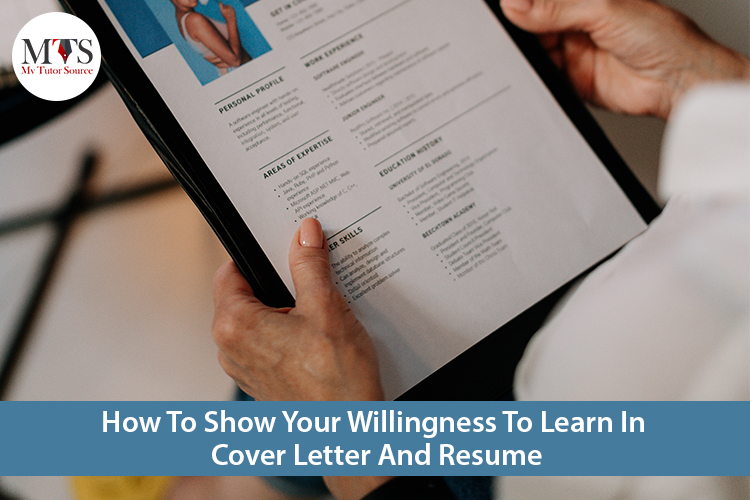

When companies look for people to hire, they look for someone eager to learn new things. If you are eager to learn new things, it will show potential employers that you are motivated, determined, and adaptable. You need these brownie points to land a promising job. Now that we have established how important it is to feel or show eagerness, the question is how to do that?
Here are some of the most effective tips that you can implement to answer the question, ‘how to show your willingness to learn in the cover letter and resume’, and make your portfolio stand out:
Mention any credentials or certificates that you have received as a part of your self-development journey. Highlight that you have taken extra time to learn courses for your learning.
For example, if you finished a training course to learn the basics of graphic designing and technicalities of different software like Photoshop, and you received a certificate for that course, mention it in your cover letter or CV. Also, add any similar credentials that you pursued in your personal time to show companies that you’ve the initiative to learn additional career development stuff. This is an effective way to show your ability to learn.

Enlist specific examples and proofs of your accomplishments to show employers that you are keen to learn. For example, you can provide details about the resources and the tools you sought out, and then used, to develop your skills in both your professional and personal life.
Once you have enlisted specific examples, make sure to explain how you continuously use those resources and accomplishments to achieve your professional and personal goals. These accomplishments can demonstrate that you are not just keen to learn new skills, but you also can use your knowledge to polish new and old skills to enhance your overall development and growth.
Many people choose to highlight only hard skills in their cover letter, forgetting the fact that employers also look for soft skills when they are looking to hire someone. So, if you have been doing the same, you need to stop that right now!
By highlighting your soft skills and hard skills on your resume and cover letter, you show employers that you are not just willing to learn, but you also have the skills that can greatly contribute to the company’s growth.
For example, if you are a software developer, you can demonstrate your willingness to learn new skills by telling employers, through your cover letter and resume, how you have used your technical skills in the past to learn and polish new software building applications. Or you can tell them how you have embraced taking on new challenges that need you to implement both your hard skills and soft skills to succeed, such as leadership, teamwork, and communication.

Mention your past accomplishments that you have pursued for your development. And enlist the good results you have achieved after applying your newly developed skills to meet your deadlines and objectives, and to play your role in the growth and success of the last organization you worked for.
For example, you can talk about a project assignment that required a skill you did not have, but you decided to pursue that skill for your growth. And you dedicated your time to learn a new technical skill, for the assignment, that increased your productivity, efficiency, and number of deliverables.
If you explain how your learning adventures have played an instrumental role in delivering positive results in your work, you will automatically stand out as a positive learner. Besides, employers will also be able to see how you have a growth mindset that can be good for their company’s growth.
Here are two tips for showing your willingness to learn in a cover letter and resume:
1. Use the STAR method when providing examples
Instead of simply listing “I’m willing to learn” or “I’m a quick learner” on your application, prove it by giving direct examples — which provides employers with the results of what you’ve learned or accomplished. A simple way to give examples is to use the STAR method. STAR stands for Situation, Task, Action, and Result.
When writing about your previous work experience in your resume and cover letter, explain the:
a. Situation you faced
b. Task you were involved in
c. Actions you took to complete the task
d. Results of what you accomplished
Your answers can be single or multiple bullet points on your resume, or even 1–3 sentences on your cover letter.
For instance, if you learned how to use a new digital tool during an online tutoring session, you could summarize a previous experience by stating:
“I taught myself how to use [Name of software] and incorporated this tool into my online lessons. Using [Name of software] positively enhanced my tutoring sessions with 5 students, which resulted in active participation and 100% parent feedback ratings.”
Using the STAR method shows employers you’re actively picking up new skills and achieving results.
2. List your certifications and professional development activities
One of the best ways to communicate that you’re eager to learn and grow is by listing any certifications, courses, or workshops you’ve completed on your resume and cover letter.
Mentioning the online or in-person certifications or credentials you’ve completed or are currently working on shows you’re:
a. committed to learning more about the industry you’re applying to
b. actively trying to expand your knowledge and skills
c. being resourceful by finding ways to learn and grow professionally
Eva Chan Certified Professional Resume Writer at Resume Genius
If you are talking about your skills and telling employers that you are eager to learn, then you also need to back up your claims by providing solid examples. Mention different examples and instances of how you participated in a certain continuing education course or a professional development training workshop. Make sure that you tell them about all the training courses and workshops you have attended just for the sake of your professional development and your love for learning new skills.
For example, if you have a certificate that has a short expiry date and you are required to renew it regularly to make sure that your skill remains fresh and up-to-date, you should mention that. The reason behind this is that if a course requires you to get continuing education credits, it shows people that you are not just doing it for the resume, but you are genuinely willing to learn. In addition, this also shows potential employers that you take your career development very seriously and you are dedicated to keeping your certifications even if they require continuing credits.
So, these are the important steps that you need to follow if you want to illustrate that you are eager to learn new skills while talking about your learning abilities. Moreover, these tips will help you ensure that you deliver the message, to a potential employer, that you like to take on new career challenges because you love to learn. Lastly, giving employers evidence that demonstrates that you are coachable proves to them that you are adaptable according to the job expectations.
Here are some additional, but super important, tips for you to show your eagerness to learn:

It is always important to show potential employers and hiring agents that not only are you coachable, you are also enthusiastic to learn new skills if that is what the job requires. However, there is one thing that you need to keep in mind at all times that you must avoid explicitly mentioning that you are ‘willing to learn’ on your cover letter. Instead, convey that you are keen to learn new skills by giving companies an idea of how your determination and enthusiasm to learn new skills will benefit both you and their organization.
And now that you know how to show your willingness to learn in cover letter, you can apply for your dream job or scholarship with confidence.